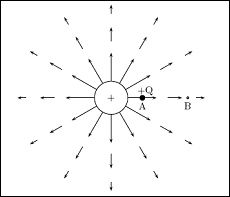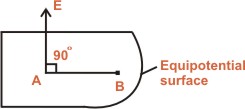Introduction to Electric Potential
When a charged particle moves in an electric field, work is done and energy transfers take place. If the electrical force moves a charge a certain distance, it does work on that charge. The change in electric potential over this distance is defined through the work done by this force:
Work done = Force X distance = (charge on Q) X (Potential)
Unit of Electric Potential

As a formula, a unit of electric potential is written as follows. The energy per unit of charge is often called voltage and so is symbolized with the capital letter V. Work or energy can be measured in Joules, and charge is measured in Coulombs. Consequently, electrical potential can be measured in Joules per Coulomb, which is defined as a volt.
![]() = 1V
= 1V
Electrical Potential Difference
Consider a positive test charge +Q placed at A in the electric field of another positive point charge. The test charge moves towards B under the influence of the electric field of the other charge. In the process the test charge loses electrical potential energy and gains kinetic energy. Thus, at A, the test charge has more potential energy than at B -- A is said to have a higher electrical potential than B. The potential energy of a charge at a point in a field is defined as the work required to move that charge from infinity to that point. The potential difference between two points in an electric field is defined as the work required to move a unit positive test charge from the point of lower potential to that of higher potential. If an amount of work W is required to move a charge Q from one point to another, then the potential difference between the two points is given by,
The test charge moves towards B under the influence of the electric field of the other charge. In the process the test charge loses electrical potential energy and gains kinetic energy. Thus, at A, the test charge has more potential energy than at B -- A is said to have a higher electrical potential than B. The potential energy of a charge at a point in a field is defined as the work required to move that charge from infinity to that point. The potential difference between two points in an electric field is defined as the work required to move a unit positive test charge from the point of lower potential to that of higher potential. If an amount of work W is required to move a charge Q from one point to another, then the potential difference between the two points is given by,
V = W/Q
Thus from the above equation we can say that one volt is the potential difference between two points in an electric field, if one joule of work is done in moving one coulomb of charge from one point to the other.
Analogy For Electric Potential
A gravitational analogy is used to explain the reasoning behind the relationship between location and potential energy. On the one hand, moving a positive test charge against the direction of an electric field is like moving a mass upward within Earth's gravitational field. Both movements are like going against nature and require work by an external force. This work would in turn increase the potential energy of the object. On the other hand, the movement of a positive test charge in the direction of an electric field is like a mass falling downward within Earth's gravitational field. Both movements are like going with nature and can happen without work by an external force. This motion would result in the loss of potential energy. Potential energy is the stored energy of a positioned object and is related to the location of the object within a field.
If two objects of different charge -- with one being twice the charge of the other -- are moved the same distance in the electric field, then the object with twice the charge would require twice the force and thus twice the amount of work. This work would change the potential energy by an amount that is equal to the amount of work that is done. Thus, the electric potential energy depends on the amount of charge on the object experiencing the field and on the location within the field. Just like gravitational potential energy, electric potential energy depends on at least two types of quantities:
1) Electric charge -- a property of the object experiencing the electrical field, and
2) Distance from source -- the location within the electric field
What is Equipotential?
A surface with constant potential is called an equipotential surface.
Consider two points A and B on an equipotential surface as shown in the figure below. 
VB - VA = 0
VB = VA
Properties of equipotential surfaces:
1. Electric field lines point from high to low potential
2. The direction of electric field lines is perpendicular to equipotential surface.
3. Equipotential surfaces produced by a point charge or spherically charge distribution are a family of concentric spheres.
4. Equipotential surfaces can never cross each other.
Want to know more about electric potential? Click here to schedule a live session with an eAge eTutor!
About eAge Tutoring:
eAgeTutor.com is the premium online tutoring provider. Using materials developed by highly qualified educators and leading content developers, a team of top-notch software experts, and a group of passionate educators, eAgeTutor works to ensure the success and satisfaction of all of its students.
Contact us today to learn more about our guaranteed results and discuss how we can help make the dreams of the student in your life come true!